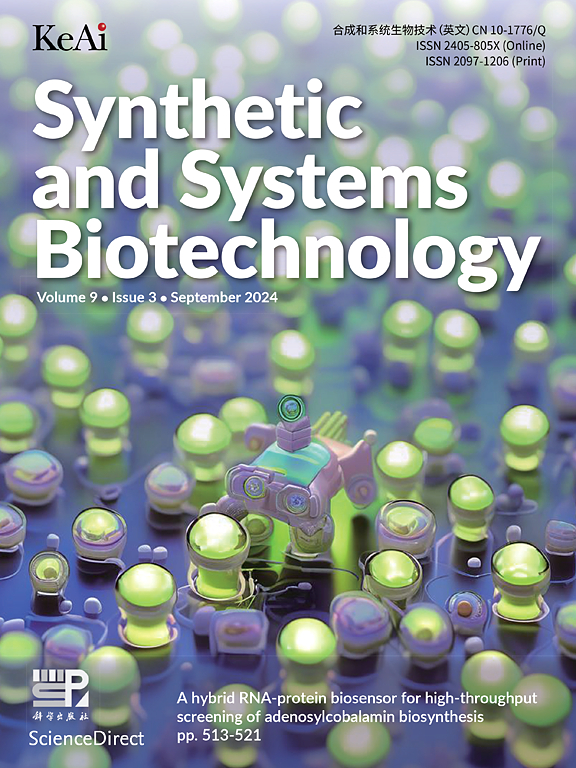Ty retrotransposon element based multiple integration toolkit for Saccharomyces cerevisiae
IF 4.4
2区 生物学
Q1 BIOTECHNOLOGY & APPLIED MICROBIOLOGY
引用次数: 0
Abstract
Extra-high-level overexpression of single or multiple specific proteins by integrating specific genes in the genome is vital to achieve the stable and efficient production of target proteins and metabolites in S. cerevisiae. Five families of Ty elements in the genome of S. cerevisiae CEN.PK2-1D, which could have dozens to hundreds of copies, have been employed to achieve massive gene expression. By engineering nine selective markers, six of them (TRP1, LEU2, URA3, HIS5, natMX and hphMX) achieve stably high copy integration (>15 copies) at Ty sites. Fluorescence proteins and taxifolin biosynthesis pathway genes were overexpressed to verify the toolkit. The titer of protein phiYFP in the multiple integration strain reached 1.6 g/L (268.1 mg/g DCW), and its fluorescence intensity was 3.3 times higher than that in the episomal overexpression strain. For taxifolin biosynthesis, 14 genes were integrated into three different Ty sites using three selective markers from the toolkit, resulting in 277.6 mg/L taxifolin accumulation from glucose.
基于反转录转座子元件的酿酒酵母多重集成工具箱
通过整合基因组中的特定基因,实现单个或多个特定蛋白的超高水平过表达,对于酿酒酵母稳定高效地生产靶蛋白和代谢物至关重要。酿酒葡萄球菌CEN基因组中5个家族的Ty元件。PK2-1D可能有几十到几百个拷贝,已经被用来实现大规模的基因表达。通过对9个选择性标记进行工程改造,其中6个(TRP1、LEU2、URA3、HIS5、natMX和hphMX)在Ty位点实现了稳定的高拷贝整合(>;15个拷贝)。荧光蛋白和taxifolin生物合成途径基因过表达来验证工具包。多重整合菌株phiYFP蛋白滴度达到1.6 g/L (268.1 mg/g DCW),荧光强度是episomal过表达菌株的3.3倍。对于杉木蛋白的生物合成,使用工具包中的三个选择性标记将14个基因整合到三个不同的Ty位点,从而从葡萄糖中积累了277.6 mg/L的杉木蛋白。
本文章由计算机程序翻译,如有差异,请以英文原文为准。
求助全文
约1分钟内获得全文
求助全文
来源期刊

Synthetic and Systems Biotechnology
BIOTECHNOLOGY & APPLIED MICROBIOLOGY-
CiteScore
6.90
自引率
12.50%
发文量
90
审稿时长
67 days
期刊介绍:
Synthetic and Systems Biotechnology aims to promote the communication of original research in synthetic and systems biology, with strong emphasis on applications towards biotechnology. This journal is a quarterly peer-reviewed journal led by Editor-in-Chief Lixin Zhang. The journal publishes high-quality research; focusing on integrative approaches to enable the understanding and design of biological systems, and research to develop the application of systems and synthetic biology to natural systems. This journal will publish Articles, Short notes, Methods, Mini Reviews, Commentary and Conference reviews.
 求助内容:
求助内容: 应助结果提醒方式:
应助结果提醒方式:


